
Macaria signaria, the dusky peacock, pale-marked angle or spruce-fir looper, is a moth of the family Geometridae. The species was first described by Jacob Hübner in 1809. Subspecies Semiothisa signaria signaria is found in Europe, Turkey, the Caucasus, Transcaucasia, the Ural, Siberia, Far East, Sakhalin, northern Iran and Japan. Subspecies Macaria signaria dispuncta is found in North America.
Macaria bicolorata, the bicolored angle, is a moth of the family Geometridae. It is found in Eastern North America.

Eumacaria is a monotypic moth genus in the family Geometridae described by Packard in 1873. Its only species, Eumacaria madopata, the brown-bordered geometer moth, was first described by Achille Guenée in 1857. It is found in North America, where it has been recorded from British Columbia, northern Washington, southern Saskatchewan, from Maine to Florida, South Dakota, North Dakota, Nebraska, Wyoming, Idaho, Colorado and New Mexico. The habitat consists of orchards and shrublands. The species is listed as threatened in Connecticut.

Macaria is a genus of moths in the family Geometridae erected by John Curtis in 1826. It is sometimes placed as a synonym of Semiothisa. Species are cosmopolitan.

Catocala meskei, or Meske's underwing, is a moth of the family Erebidae. The species was first described by Augustus Radcliffe Grote in 1873. It is found in North America from Maine and Quebec west to southern Alberta and Montana, south to South Carolina in the east and at least Montana in the west.

Lophocampa maculata, the Yellow-spotted tussock moth, mottled tiger or spotted halisidota, is a moth of the family Erebidae and the tribe Arctiini, the tiger moths. The species was first described by Thaddeus William Harris in 1841. It is found across Canada, the western parts of the United States, south in the Appalachians to South Carolina and Kentucky. They are also found in Southeastern Alaska.

Macaria abydata, commonly known as the dot-lined angle, is a moth of the family Geometridae. It is native from northern Argentina to the Caribbean and southern United States. It has been introduced to the Pacific and has spread rapidly since. The first introduction occurred in Hawaii in 1970. Further spread occurred as follows:
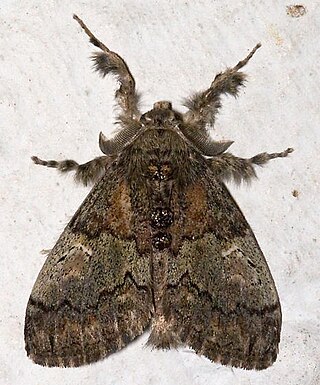
Dasychira basiflava, the yellow-based tussock, is a moth of the family Erebidae. The species was first described by Alpheus Spring Packard in 1865. It is found in North America from Massachusetts and southern Ontario west to Iowa, Texas, south to South Carolina and possibly Florida. It is also found in Southeastern Alaska.
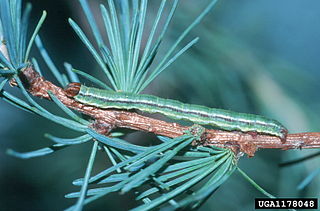
Macaria oweni, Owen's larch looper or Owen's angle moth, is a moth of the family Geometridae. The species was first described by Louis W. Swett in 1907. It is found in North America from Newfoundland to west-central Alberta, south in the east to northern New England.
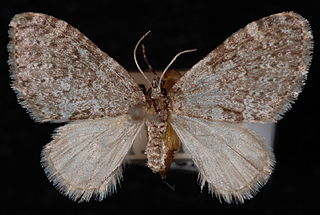
Acasis viridata, the olive-and-black carpet, is a species of moth belonging to the family Geometridae. It was described by Alpheus Spring Packard in 1873. It is found from Newfoundland to British Columbia and the adjacent northern part of the United States, south in the east to Florida, and south in the west to Colorado and Oregon.
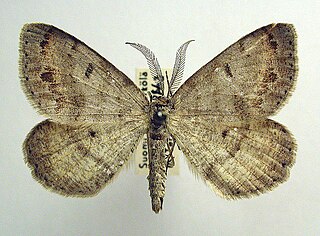
Macaria loricaria, the false Bruce spanworm or Eversmann's peacock, is a moth of the family Geometridae. It is found from Fennoscandia and the Baltic states to Sakhalin. It is also found in North America, where it is found from Alaska to Newfoundland and New York, south to Colorado.

Macaria carbonaria, the netted mountain moth, is a moth of the family Geometridae. The species was first described by Carl Alexander Clerck in 1759. It is found in the northern part of the Palearctic realm.
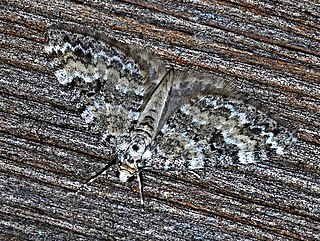
Perizoma minorata, the heath rivulet, is a moth of the family Geometridae. The species was first described by Georg Friedrich Treitschke in 1828.

Macaria aemulataria, the common angle moth, is a moth in the family Geometridae. The species was first described by Francis Walker in 1861. It is found from Nova Scotia to Florida, west to Texas, north to Oregon and Alberta.
Digrammia subminiata, the vermillion granite or dark-waved angle, is a moth of the family Geometridae. The species was first described by Alpheus Spring Packard in 1873. It is found in western North America from British Columbia to Manitoba, south through Colorado to Arizona and California.

Nepytia umbrosaria is a moth of the family Geometridae first described by Alpheus Spring Packard in 1873. It is found in North America, including Arizona, British Columbia, California, Oklahoma, Oregon and Washington.

Eupithecia zygadeniata is a species of moth in the family Geometridae. It was first described by Alpheus Spring Packard in 1876 and is found in North America, with records from Texas and Montana. Adults have been recorded on wing in June and July.

Pyrausta californicalis, the California pyrausta moth or Mint Moth, is a moth in the family Crambidae. It was described by Alpheus Spring Packard in 1873. It is found in North America, where it has been recorded from British Columbia to California.

Macaria aequiferaria, the woody angle moth, is a moth of the family Geometridae. The species was first described by Francis Walker in 1861. It is found in North America, where it has been recorded from Maryland, and Delaware to Florida, west to Texas, as well as in Oklahoma, Mississippi, Kentucky and southern Illinois. It is also found in Mexico.

Idaea furciferata, the notch-winged wave moth, is a moth in the family Geometridae. It is found in North America, where it has been recorded from Maryland to northern Florida, west to Missouri and Texas.

















